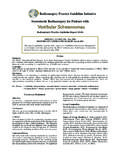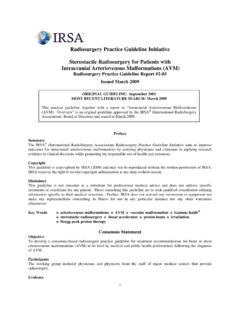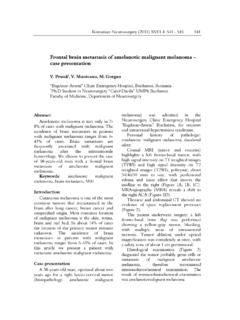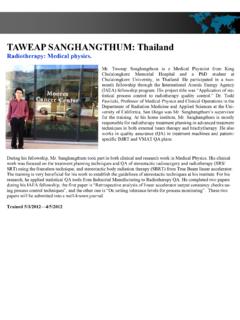Transcription of Radiation Protection in Educational Institutions, …
1 Power to Save the World: the Truth about NuclearEnergy,by Gwyneth Cravens, 2007, 371 pp. notes andglossary (hard cover), $ (US), $ (Canadian), AlfredA. Knopf, NewYork; ISBN 978-0-307-26656-9; a reader of fiction, so when asked to reviewGwyneth Cravens new book about nuclear energy I was some-what hesitant. However, after I agreed and began reading the book,I did not regret my decision. Ok, I have not changed my preferencefor fiction, but I must say that Cravens writes an intriguing cleverly weaves good but easily understandable scientificdescriptions of complex issues with interesting anecdotes, takingus along with her on her journey to better understand the benefitsand risks of nuclear story is as much of a personal voyage as it is a narrative onnuclear power.
2 She begins the book as a self-declared anti-nuclearwith a series of questions. Accompanied and guided by Dr. RipAnderson along a journey to answer these questions, she meetsvarious other notable waste management, Radiation Protection , andnuclear engineering experts, and she comes to change her view. Inthe end, as a result of her visits to various nuclear facilities anddiscussions with many knowledgeable experts, again mostlythanks to the involvement of Dr. Anderson, she has changed hermind and sees the green side of nuclear power very little CO2emission and a very reliable and long-term supply of relativelyinexpensive fuel in an era of growing demand for electricity and aclimate change crisis.
3 The book is very up-to-date, quoting fromthe latest studies and news of the day, providing a convincingargument as to why nuclear power really should have a much moresignificant role in the energy and climate change I didn t appreciate about the book was the fact that,although Cravens quoted many eminent scientists, her selectionwas very one sided in the sense that most of them are well knownuclear advocates, such as Ted Rockwell, Bruno Comby, or JamesMuckerheide. She also seemed to rely heavily on the argument thatignorance of the real risks of nuclear power is a key reason foranti-nuclear sentiments.
4 The first half of the book is full of validcomparisons of the risks of low-dose exposure, but these areusually presented in a void, that is, not discussing the benefits onewould get while accepting such risks. Personally, I understand thatradiation risks are very low, but I still insist that my dentist spendthe extra few seconds aiming the x-ray machine as I painfully biteon the film so that a second x ray is not necessary no one I knowis willing to accept even the lowest risk without some benefit the radiological risks, which represent a key problem toacceptance, are presented as being very low.
5 The book stresses that Radiation Protection standards based on hard data rather than onthe present pessimistic and inconsistent estimates regardinglow-dose Radiation could potentially save billons of dollars nowbeing spent for cleanup and shielding that may turn out to beunnecessary (p. 123). Or that there is no evidence of humancancers from exposures below 10,000 mrem (p. 123). Although Ido not wish to jump into the linear no-threshold (LNT) argument,there are other, scientifically founded views based on hard data that come to other opinions than expressed in Cravens book.
6 Butwhether one is in the LNT camp or the Threshold camp, Iwould argue that presenting both sides of the story is a journalist sduty, and in my view it is a much more convincing way topersuade others that your views are worth , I must say that I enjoyed reading this book, and that I willrecommend it to friends. I commend the author not only on herdiligent respect for good science, but for her artful presentation ofscientists as caring, hard-working, honest people. I do, however,find the somewhat one-sided approach unnecessary because, in ourworld, where climate change is increasingly recognized as real andfor the moment as being something that we can influence, thebenefits of nuclear power seem to have a growing number ofadvocates, and its risks seem to be viewed as acceptable if Nuclear Energy Agency12boulevard des Protection in Educational Institutions, NCRP Report No.
7 157, Radiation Protection in Educa-tional Institutions, 2007, 155 pp. (hard cover), $ ,PDF $ , National Council on Radiation Protectionand Measurements, 7910 Woodmont Avenue, Suite 400,Bethesda, MD 20814-3095; ISBN-13: 978-0-929600-94-9; on Radiation Protection and Measurements(NCRP) has prepared NCRP Report No. 157, Radiation Protectionin Educational Institutions. This report supersedes the similarlytitled NCRP Report No. 32 released in 1966. The substantivechapters address: Radiation Basics and Protection ; Types Loca-tions and Uses of Sources; Legal and Regulatory Responsibilities;Administrative Responsibilities; Radiation Safety Program Man-agement; and Checklists and Appendices, summarizing usefulinformation and following excerpt from the Executive Summary reflects theintended audience: This report is intended primarily for thoseinstitutions that do not need a full-time Radiation safety profes-sional because the uses and Radiation levels of the sources arelimited.
8 In these instances, an individual with limited expertise inradiation safety ( , a professor, teacher, researcher, or generalsafety staff member) could assume the responsibility for imple-menting the Radiation safety program. Unfortunately, a large portion of this target audience may not befamiliar with the NCRP, and I fear the demand for this publicationwill be light. While NCRP Report No. 157 is not perfect, full-timeradiation safety professionals who may be in a position to advisesmaller or fledgling programs are encouraged to recommend is enough valuable information for the dedicated, part-timeradiation safety professional to justify the modest price my opinion, the highlights of the report are: Chapter 4, Types, Locations and Uses of Sources Thischapter is an excellent summary of the typical uses ofradioactive materials and sources of ionizing Radiation ineducational institutions and may help small programs iden-tify areas that may need attention.
9 Chapter 5, Legal and Regulatory Responsibilities Thischapter very simply directs the reader as to what type of259 Book Reviewslicense(s), if any, may be required and what regulatoryagencies may have jurisdiction; Chapter 6, Administrative Responsibilities This chapterprovides guidance and references to administrators as to theresponsibilities required of an institution and a good idea ofthe scope of what a Radiation safety program should look likeat their reviewing this report, I longed for a simpler documentthat would be an easier read and less intimidating for the targetaudience.
10 The sheer quantity of information provided in Chap-ters 3 and 7, entitled Radiation Basics and Protection and Radiation Safety Program Management, would be difficult todigest if one were not already familiar with the material. Apart-time Radiation safety professional or administrator respon-sible for a small Radiation safety program could easily beoverwhelmed by the information. I recognize that in today slitigious society and more sophisticated regulatory climate,simplicity can be an elusive target, and I understand thechallenges this must have presented to the conclusion, NCRP Report No.





